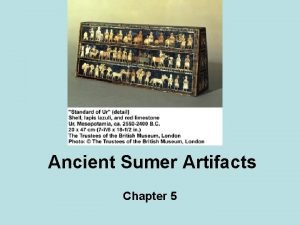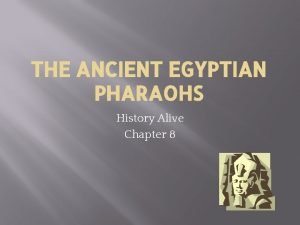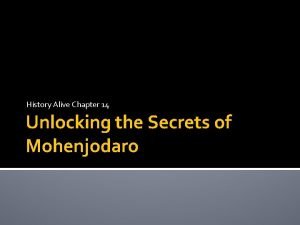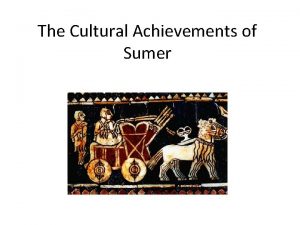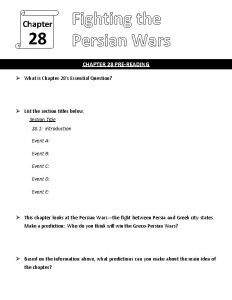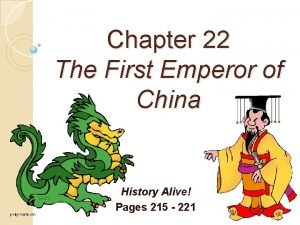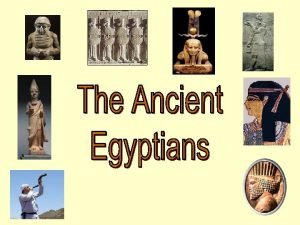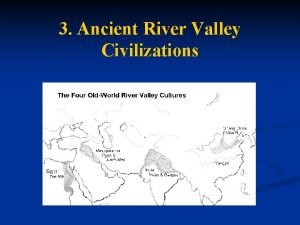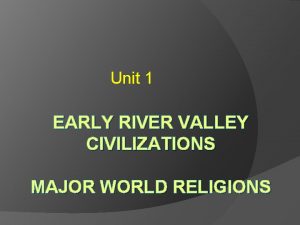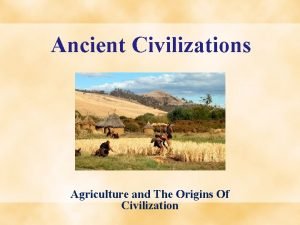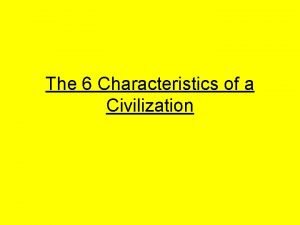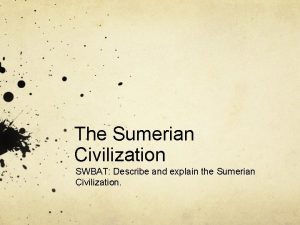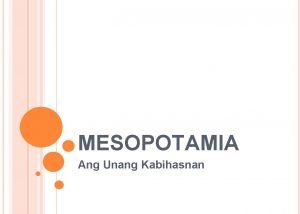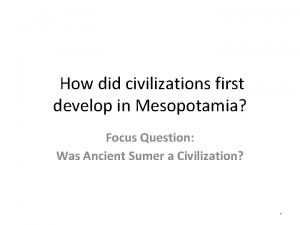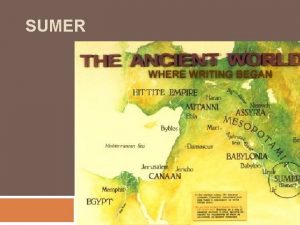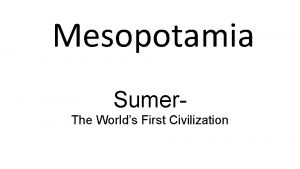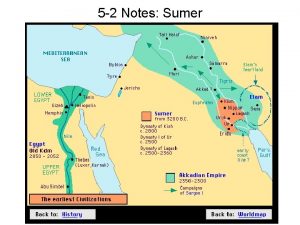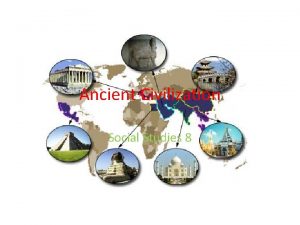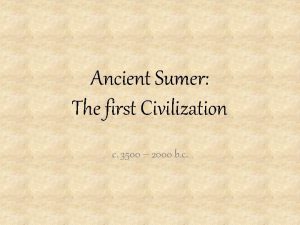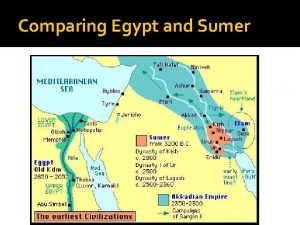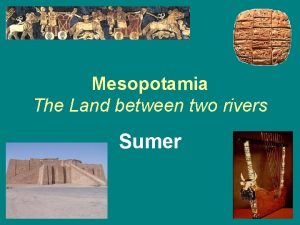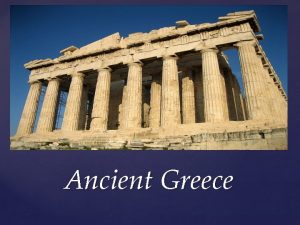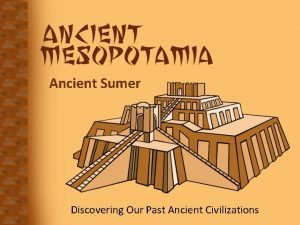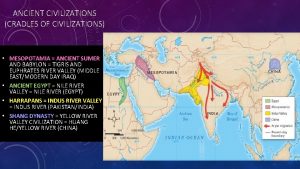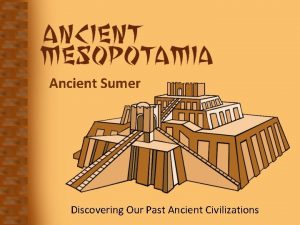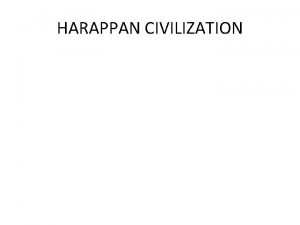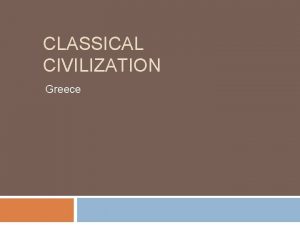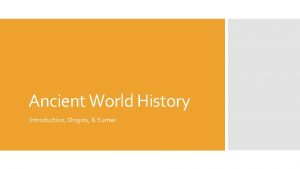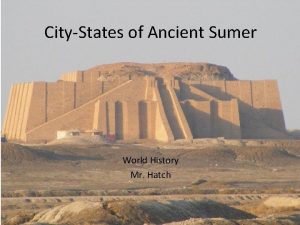Was Ancient Sumer a Civilization History Alive Chapter

























- Slides: 25

Was Ancient Sumer a Civilization? History Alive Chapter 5

5. 1 Introduction �Focus on Sumerian culture. �In 1800’s archeologists bean finding artifacts in Mesopotamia. �By studying artifacts the archeologists have learned about Sumer. �One artifact is the Standard of Ur.

Standard of Ur �It was found where the city of Ur once stood. �It is made of wood and decorated with shell and lapis lazuli. �It shows the Sumerians in war and at peace.

Standard of Ur

Characteristics of a Civilization Stable food supply Social structure System of governme nt Religious system Highly developed culture including Written painting, technology language architectur e, music, and literature

5. 3 Stable Food Supply �A stable food supply is what allows people in a society to have the food they need in order to survive.

Two Sumerian inventions that helped create a stable food supply �Complex irrigation system including canals, dams, and reservoirs to provide their crops with water. �The plow is a tool used for turning the soil to prepare it for planting.

5. 4 Social Structure �A social structure is the way a society or civilization is organized. Uppe r Class Comm on Class Slaves

Sumerian Social Class Structure Priests Land owners Government Officials Upper Class These people had large and luxurious two story homes near the center or the city.

Sumerian Social Class Structure Merchants and Craftspeople • Metalworkers — • Famers • Fisherman Common Class Lived in small, mud-brick houses at the edge of the city.

Sumerian Social Class Structure Lived in their owners’ homes and owned no property. Slaves

5. 5 Government �The people or groups that rule a particular region. �Sumerian city-states were ruled by kings who they believed were chosen by Sumerian Gods.

Sumerian Kings �Enforced laws and collected taxes. �Built temples. �Maintained the irrigation system. �Led his army to war. List of the Sumerian Kings

Sumerian Government �Sumerian Army �Governors �Scribes �Irrigation Patrol

5. 6 Religion �A religious system includes a set of beliefs, usually in god or gods, together with forms or worship. �Sumerians built ziggurats. �A ziggurat is an ancient Mesopotamian temple tower.

5. 7 The Arts �All civilizations have a highly developed culture, including the arts. Arts include creative forms of expression such as painting, architecture, and music.

Artists and Craftspeople in Sumer �Sumerian metalworkers made weapons, cups, mirrors, jewelry. �Artisans also decorated the ziggurats.

Sir Charles Leonard Woolley British archaeologist Charles Leonard Woolley (April 17, 1880 -February 20, 1960) became famous for the artifacts and information he uncovered during his magnificent excavations at Ur. Woolley is noted as one of the first modern archaeologists, and was knighted in 1935 for his services to archaeology. � Born in London to a clergyman, Woolley graduated from New College in Oxford, and in 1905 he became Assistant Keeper of the Ashmolean Museum, Oxford. In 1922, Woolley was chosen by the British Museum and the University of Pennsylvania to lead the famous excavation at Ur. The excavations of the temple complex and the ziggurat in the city complex were impressive but it was the Royal Cemetery of Ur which proved to be the most amazing archeological find of the period. His most important discovery was the tomb of "Queen" Puabi. Miraculously untouched by looters, her tomb contained thousands of beads and other pieces of jewelry including a seal bearing her name in Sumerian. Buried with her were her attendants, guards and musicians who had participated in the funerary ceremony. Woolley was adept in conserving objects while they were still in the ground. Filling the lost wooden elements with wax, dowels, and plaster, he was able to reconstruct the form of many objects. His work at Ur, which ended in 1934, added tremendous amounts of information to our knowledge of this early period. � Unwilling to rest on the laurels brought by the work at Ur, he also excavated at the sites of Tell Atchana and al-Mina in Syria. In addition to � Discovered the treasures from the Royal Tombs of Ur

Sumerian Architects designed ziggurats.

Sumerian Musicians �Played the drums, pipes, and a small harp called a lyre. �Lyres were wooden instruments made of a sound box and strings. �The lyres were also decorated.

5. 8 Technology �The use of tools and other inventions for practical purposes. �Sumerians invented the wheel.

5. 8 Technology �Sumerians also invented the arch. �An arch is an upside down U- or V-shaped structure that supports weight above it, as in a doorway.

5. 9 Writing �The Sumerians created a written language called cuneiform. �The names comes from the Latin word for “wedge. ” �The Sumerians used a wedge-shaped stylus to etch their writing in clay tablets.

5. 10 Chapter Review �Was Sumerian culture a civilization? �What are the characteristics of a civilization? ( sfs, ss, g, r, a, t, wl)

The End
 Beavers in loves jesus cristo
Beavers in loves jesus cristo Artifact
Artifact History alive the ancient world chapter 8
History alive the ancient world chapter 8 History alive chapter 14
History alive chapter 14 Chapter 3 from hunters and gatherers to farmers
Chapter 3 from hunters and gatherers to farmers He's alive frankenstein
He's alive frankenstein Achievements of sumer
Achievements of sumer Chapter 28 history alive
Chapter 28 history alive China’s first emperor was ______.
China’s first emperor was ______. Drawing 9th amendment
Drawing 9th amendment History alive pursuing american ideals
History alive pursuing american ideals History alive online textbook
History alive online textbook Ancient egypt civilization geography
Ancient egypt civilization geography Ancient chinese civilization
Ancient chinese civilization Ancient egypt civilization
Ancient egypt civilization Ancient civilization agriculture
Ancient civilization agriculture Means of communication in ancient times
Means of communication in ancient times Ancient india vs ancient china
Ancient india vs ancient china Chapter 2 chemistry comes alive answer key
Chapter 2 chemistry comes alive answer key Chapter 2 chemistry comes alive
Chapter 2 chemistry comes alive What are characteristics of civilization
What are characteristics of civilization Ziggurats
Ziggurats Gulong kabihasnan
Gulong kabihasnan Sumer geography
Sumer geography Sumer geography
Sumer geography Akkadians long ago
Akkadians long ago

